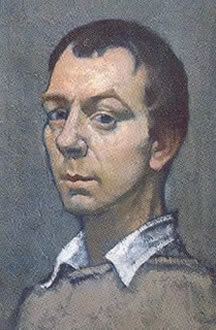Nationality English Name John Copnall | Role Artist | |
Known for Painting (Landscape & Abstract) Awards 1988 Elected member of The London Group Died June 9, 2007, London, United Kingdom Education Royal Academy of Arts, Architectural Association School of Architecture | ||
Parents Edward Bainbridge Copnall | ||
John copnall
John Bainbridge Copnall (1928–2007) was an English artist best known for his abstract expressionist painting of richly coloured stylised realism, often on a grand scale. He was also a teacher of painting for twenty years at the Central School of Art and Design in London.
Contents
- John copnall
- John Copnall Painting
- Early life
- His Career in Spain
- Return To England
- Later years in London
- Selected Solo Exhibitions
- Selected Public Collections
- References

John Copnall: Painting
Early life

John Copnall was born in Slinfold, a village near Horsham in West Sussex. His father was the eminent sculptor Edward Bainbridge Copnall (1903–1970) whilst his mother Muriel, his uncle and aunt Frank and Theresa Copnall were all enthusiastic amateur artists. Another uncle, Hubert Copnall (1918–1997), was also an artist and sculptor, although he spent over thirty years farming, having been initially so required as a World War II conscientious objector. His paternal grandfather EW Copnall was an early photographer and artist.

Copnall showed early promise in drawing and his strong draughtsman skills would be at the heart of his work throughout his painting life. At the age of eighteen he began studies at the Architectural Association in London. This proved a poor choice of a career as Copnall lacked the required mathematical ability and used the excuse of his National Service to leave the profession permanently in order to become a professional artist
His Career in Spain

Initially Copnall started his painting studies under the tutelage of his father at the Sir John Cass School of Art in the City of London and from 1949 under the artist Sir Henry Rushbury at the Royal Academy School. His early work is largely figurative and he won the prestigious Turner Gold Medal for Landscape Painting in his final year in 1954.
In 1954 he and his friend Bert Flugelman visited Spain for what was intended to be a short visit. The effect was almost instant and he fell in love with the Iberian landscape staying for fourteen years. Whilst on Ibiza he married his first wife Madeleine Chardon with whom he had a daughter and when the marriage ended he moved to the mainland to live in a hacienda in the mountains above Malaga where he earned a living as a painter sometimes using the name of Juan de Retamá. The intense light of Spain and the visceral nature of its people changed his art fundamentally as he experimented with intense earthy colours whilst increasingly moving towards abstraction. Throughout his career Copnall was interested in using intense colour and the Spanish light undoubtedly enhanced his artistic senses.
As the 60’s progressed Copnall became fashionable and he began to sell his paintings to private collectors that included Melvyn Douglas. He had several solo exhibitions in Spain and Catalonia as well as shows in Germany where he was also popular and a lesser one in England in Newcastle. He said of his life in the 1960s: "No Beatles, but plenty of bullfighting, flamenco and Rioja!"
Return To England
In 1968 John Copnall returned to England and the following year held a solo exhibition at the Bear Lane Gallery in Oxford. His work was clearly influenced by that of American abstract expressionists such as Barnett Newman, Morris Louis and Mark Rothko with Copnall using acrylic paint on cotton duck on increasingly larger canvasses. His use of colour was exuberant. 'Painting is colour and colour is painting." said Copnall. In 1970 he won the E A Abbey Scholarship and further recognition followed with Art Council awards in 1973 and a British Council Award in 1979. As the 60s progressed abstract art began to lose influence as new ‘pop’ style were in vogue and to some extent Copnall found himself less fashionable during the late 70s and 80s.
A series of solo exhibitions were held throughout the 1970s but Copnall was becoming a peripheral figure in the context of mainstream English art. Nevertheless, his influence on the next generation of British artists is evident following a twenty-year period from 1973 to 1993 when Copnall worked as a teacher at the Canterbury School of Art and the Central School of Art and Design. He had married for the second time in 1976 to Caroline Brown with whom he had a son and a daughter and he required the financial stability that teaching provided.The marriage was dissolved in 1997.
Later years in London
He was by 1982 working in an artists' colony in the East End of London having bought the defunct Spratts Dog Food warehouse in Bow whilst continuing his teaching role.
In 1996 his solo show "Reflections, Orbits and Radiances" in the sympathetic surroundings of the De La Warr Pavilion in Bexhill-on-Sea, Sussex drew mainly on work done in the period 1992-96. In the catalogue, Christopher Lloyd, Surveyor of the Queen's Pictures, considered that it was "difficult to think of a more appropriate setting for John Copnall's paintings" than this light-filled example of pioneering mid-1930s architecture.
In 1988 John Copnall was elected to the important London Group, an artists' exhibiting society based in London dating from 1913 and founded to help independent minded artists challenge the pre eminence of the Royal Society by promoting radical thought in English art. It was a natural place for the independent minded Copnall.
During the final years of his life Copnall painted infrequently and ceased all together following a stroke. He died on 9 June 2007 following a short illness.
A memorial exhibition was held by Mark Barrow Fine Art (who represent the artists' estate) in London in October 2007. Works by John Copnall are available exclusively from www.markbarrowfineart.co.uk
